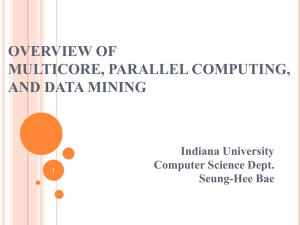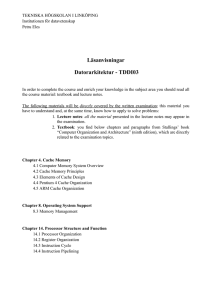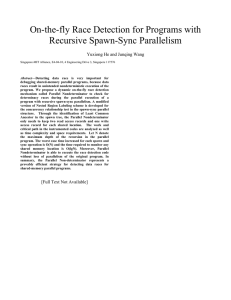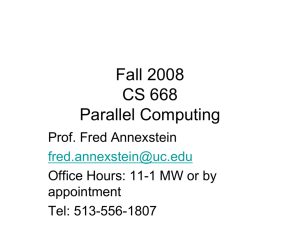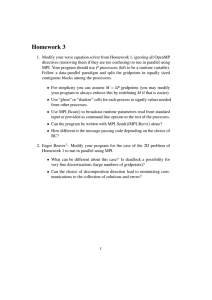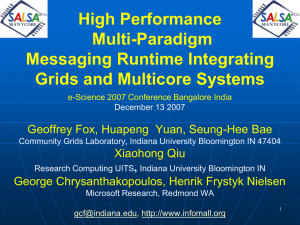OVERVIEW OF MULTICORE, PARALLEL COMPUTING, AND DATA MINING Indiana University
advertisement
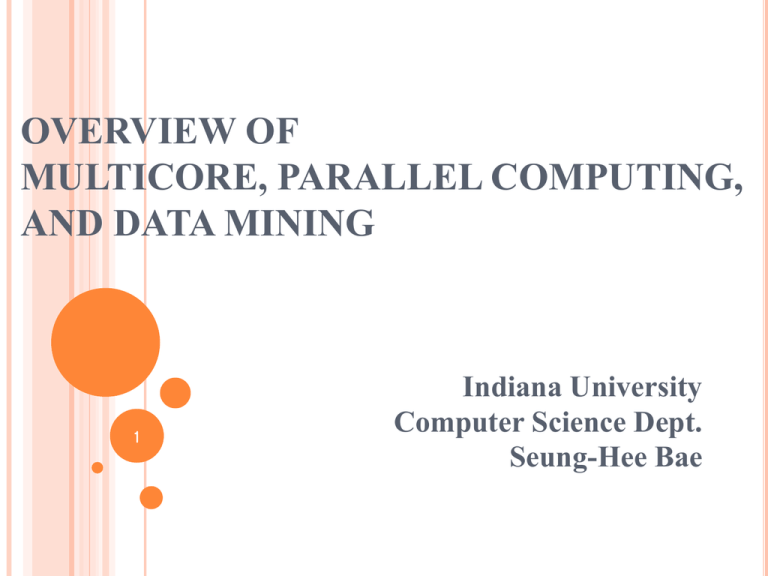
OVERVIEW OF
MULTICORE, PARALLEL COMPUTING,
AND DATA MINING
1
Indiana University
Computer Science Dept.
Seung-Hee Bae
1
OUTLINE
Motivation
Multicore
Parallel Computing
Data Mining
2
MOTIVATION
According to “How Much Information” project at UC Berkeley
Print, film, magnetic & optical storage media produced about 5 exabytes
(a billion of billion bytes) of new info. in 2002.
5 exabytes = 37000 Library of Congress (17 million books)
The rate of data increase will continue to accelerate through weblogs,
digital photo & video, surveillance monitor, scientific instruments
(sensors), and instant message etc.
Thus, we need more powerful computing platforms to deal with
this much data.
To take advantage of multicore chip, it is critical to build a software with
scalable parallelism.
To deal with a huge amount of data and utilize multicore, it is essential to
develop data mining tools with highly scalable parallel programming.
3
RECOGNITION, MINING, AND
SYNTHESIS (RMS)
(from P.Dubey, “Recognition, Mining and Synthesis Moves Computers to the Era of Tera,” Technology@Intel
Magazine, Feb. 2005.)
Intel points out these three processing cycle will be necessary to
deal with most generalized decision support (data mining).
Examples
Medicine (a tumor)
Business (hiring)
Investment
4
Motivation
Multicore
Toward Concurrency
What is Multicore?
Parallel Computing
Data Mining
5
TOWARD CONCURRENCY IN SOFTWARE
Previous CPU performance gains
Exponential growth (Moore’s
Law) will change
Clock speed: getting more cycles
Increasing the size of on-chip cache:
main memory is much slower than
the cache.
Moore’s law is over?
Not yet (# of transistors ↑)
Hyperthreading
Running two or more threads in
parallel inside a single CPU
It doesn’t help single-threaded
applications
Multicore
Running two or more actual CPUs on
one chip.
It will boost reasonably well-written
multi-thread applications, but not
single-threaded applications.
Pipelining, branch prediction,
multiple instructions/clock,
reordering the instruction
Cache
Become harder to exploit higher
clock speeds (2GHz:2001,
3.4GHz:2004, now?)
Execution optimization: more
work per cycle
Current CPU performance gains
Cache
Only this will broadly benefit most
existing applications.
6
A cache miss costs 10 to 50 times.
WHAT IS MULTICORE?
Single Chip
Multiple distinct processing Engine
E.g.) Shared-cache Dual Core Architecture
Core 0
Core 1
CPU
CPU
L1 Cache
L1 Cache
L2 Cache
7
Motivation
Multicore
Parallel Computing
Parallel architectures (Shared-Memory vs. Distributed-Memory)
Decomposing Program (Data Parallelism vs. Task Parallelism)
MPI and OpenMP
Data Mining
8
PARALLEL COMPUTING: INTRODUCTION
Parallel computing
More than just a strategy for achieving good performance
Vision for how computation can seamlessly scale from a single processor
to virtually limitless computing power
Parallel computing software systems
Goal: to make parallel programming easier and the resulting applications
more portable and scalable while achieving good performance.
Component Parallel Paradigm (Explicit Parallel)
One explicitly programs the different parts of a parallel application.
E.g.) MPI, PGAS, CCR & DSS, Workflow, DES
Program Parallel Paradigm (Implicit Parallel)
One writes a single program to describe the whole app. compiler and runtime
break up the program into the multiple parts that execute in parallel.
E.g.) OpenMP, HPF, HPCS, MapReduce
Parallel Computing Challenges
Concurrency & Communication
Scalability and portability are difficult to achieve.
Diversity of Architectures
9
PARALLEL ARCHITECTURE 1
Shared-memory machines
Have a single shared address
space that can be accessed by
any processor.
Examples
Multicore
Symmetric multiprocessor (SMP)
Uniform Memory Access (UMA)
Distributed-memory
machines
Access time is independent of
the location.
Use bus or fully connected net.
Hard to achieve the scalability
The system memory is packaged
with individual nodes of one or
more processors (c.f. Use separate
computers connected by a
network)
E.g.) Cluster
communication is required to
provide data from a processor to a
different processor.
10
PARALLEL ARCHITECTURE 2
Shared-Memory
Distributed Memory
Pros
• Lower latency and higher BW
• Data are available to all of the CPUs
through load and store instructions
• Single address space
• Scalable, if a scalable
interconnection network is used.
• Quite fast local data access.
Cons
• cache coherency should be
dealt with carefully.
• synchronization is explicitly
needed to access shared data.
• scalability issue
• Communication required to
access data in a diff. processor.
• Communication management
problem
1. Long latency
2. Long transmission time
11
PARALLEL ARCHITECTURE 3
Hybrid
systems
Distributed shared-memory (DSM)
Distributed-memory machine which allows a processor to directly
access a datum in a remote memory.
Latency varies with the distance to the remote memory.
Emphasize the Non-Uniform Memory Access (NUMA)
characteristics.
SMP clusters
distributed-memory system with SMP as a unit.
12
PARALLEL PROGRAMMING MODEL
Shared-Memory Programming model
Need for synchronization to preserve the integrity
More appropriate to shared-memory machine
E.g.) Open Specifications for MultiProcessing (OpenMP)
Message-Passing Programming model
Send-receive communication steps.
Communication is used to access a remote data location.
More appropriate to distributed-memory machine
E.g.) Message Passing Interface (MPI)
Shared-memory programming model can be used to distributedmemory machines as well as message-passing programming
model can be used to shared-memory architectures.
However, the efficiency of the programming model is different.
13
PARALLEL PROGRAM: DECOMPOSITION 1
Data Parallelism
Subdivides the data domain of a
problem into multiple regions and
assigns different processors.
Exploit the parallelism inherent in
many large data structures.
Same Task on diff. data. (SPMD)
More commonly used in scientific
problems.
Features
natural form of scalability.
Hard to express when geometry
irregular or dynamic
Can be expressed by ALL parallel
programming models (i.e. MPI,
HPF like, OpenMP like)
Functional Parallelism
Different processors carry out
different functions.
Coarse grain parallelism
Different task on the same or
different data.
Features
Parallelism limited in size
Tens not millions
Synchronization probably good
Parallelism and Decomposition can
be derived from problem structure.
E.g.) workflow
14
PARALLEL PROGRAM: DECOMPOSITION 2
Load balance and scalability
Scalable: running time is inversely proportional to the number of
processors used.
Speedup(n) = T(1)/T(n)
Second definition of scalability: scaled speedup
Scalable if speedup(n) ≈ n
Scalable if the running time remains the same when the number of
processors and the problem size are increased by a factor of n.
Why scalability is not achieved?
a region that must be run sequentially. Total speedup ≤ T(1)/Ts
(Amdahl’s Law)
Require for a high degree of communication or coordination.
Poor load balance (major goal of parallel programming)
If one of the processors takes half of the parallel work, speedup will be
limited to a factor of two.
15
MEMORY MANAGEMENT
Memory-Hierarchy Management
Blocking
Ensuring that data remains in cache between subsequent accesses to the
same memory location.
Elimination of False Sharing
False sharing: When two diff. processors are accessing distinct data
items that reside on the same cache line.
Ensure that data used by diff. processors reside on diff. cache line.
(by padding: inserting empty bytes in a data structure.)
Communication Minimization and Placement
Move send and receive commands far enough apart so that time spent
on communication can be overlapped.
Stride-one access
Programs in which the loops access contiguous data items are much
more efficient than those that do not.
16
MESSAGE PASSING INTERFACE (MPI)
Message Passing Interface (MPI)
A specification for a set of functions for managing movement of data
among sets of communicating processes.
The dominant scalable parallel computing paradigm with scientific
problem.
Explicit message send and receive using rendezvous model.
Point-to-point communication
Collective communication
Commonly implemented in terms of an SPMD model
All processes execute essentially the same logic.
Pros:
scalable and portable
Race condition avoided (implicit synch. w/ completion of the copy)
Cons:
implements details at communication.
17
MPI
6 Key Functions
MPI_INIT
MPI_COMM_SIZE
MPI_COMM_RANK
MPI_SEND
MPI_RECV
MPI_FINALIZE
Collective Communications
Barrier, Broadcast, Gather, Scatter, All-to-all, Exchange
General reduction operation (sum, minimum, scan)
Blocking, nonblocking, buffered, synchronous messaging
18
OPEN SPECIFICATIONS FOR
MULTIPROCESSING (OpenMP) 1
Appropriate to uniform-access, shared-memory.
A sophisticated set of annotations (compiler directives) for traditional
C, C++, or Fortran codes to aid compilers producing parallel codes.
It provides parallel loops and collective operations such as summation
over loop indices.
Provide lock variables to allow fine-grain synchronization btwn threads.
Specify where multiple threads should be applied, and how to assign
work to those threads.
Pros:
Excellent programming interface for uniform-access, shared-memory machines.
Cons:
No way to specify locality in machines w/ non-uniform shared-memory or
distributed memory.
Cannot express all parallel algorithms.
19
OpenMP 2
Directives: instruct the compiler to
Create threads, perform synchronization ops, manage shared memory.
Examples
PARALLEL DO ~ END PARALLEL DO
SCHEDULE (STATIC)
SCHEDULE (DYNAMIC)
REDUCTION(+: x)
PARALLEL SECTIONS
OpenMP synchronization primitives
Critical sections
Atomic updates
Barriers
20
Motivation
Multicore
Parallel Computing
Data Mining
Expectation Maximization (EM)
Deterministic Annealing (DA)
Hidden Markov Model (HMM)
Other Important Algorithms
21
EXPECTATION MAXIMIZATION (EM)
Expectation Maximization (EM)
A general algorithm for maximum-likelihood (ML) estimation where
the data are “incomplete” or the likelihood function involves latent
variables.
An efficient iterative procedure
Goal: estimate unknown parameters, given measurement.
Hill climbing approach guarantee to reach maxima (or local maxima.)
Two Steps
E-step (Expectation): the missing data are estimated given the observed data and
current estimate of the model parameters.
M-step (Maximization): the likelihood function is maximized under the
assumption that the missing data are known. (The estimated missing data from the
E-step are used in lieu of the actual missing data.)
Those two steps are repeated until the likelihood converges.
22
DETERMINISTIC ANNEALING (DA)
Purpose: avoid local minima (optimization)
Simulated Annealing (SA)
A sequence of random moves is generated and the random decision to
accept a move depends on the cost of resulting configuration relative to the
current state cost (Monte Carlo Method)
Deterministic Annealing (DA)
Uses expectation instead of stochastic simulations (random move).
Deterministic:
Making incremental progress on the average.
(minimize the free energy (F) directly)
Annealing:
still want to avoid local minima with certain level of uncertainty.
Minimizing the cost at prescribed level of randomness (Shannon Entropy)
eq) F = D – TH (T: temperature, H: Shannon Entropy, D: cost)
At large T, entropy (H) dominates while at small T cost dominates.
Annealing lowers temperature so solution tracks continuously
23
DA FOR CLUSTERING
This is an extended K-means algorithm.
Start with a single cluster giving as solution Y1 as centroid
For some annealing schedule for T, iterate above algorithm testing
covariance matrix in Xi about each cluster center to see if
“elongated”
Split cluster if elongation “long enough” phase transition
You do not need to assume number of clusters but rather a final
resolution T or equivalent
24
At T=0, uninteresting solution is N clusters; one at each point xi
DA CLUSTERING RESULTS (GIS)
Age under 5 vs. 25 to 34
Age under 5 vs. 75 and up
25
HIDDEN MARKOV MODEL (HMM) 1
Markov Model
A system being in one of a set of N
distinct states, S1, S2, …, SN at any
time.
State transition probability
The special case of a discrete, first
order Markov chain:
P[qt=Sj|qt-1=Si, qt-2=Sk, …]
= P[qt=Sj|qt-1=Si] (1)
Consider the right-hand side of (1)
is independent of time, thereby
leading to the set of state transition
probability aij of the form
aij = P[qt = Sj|qt-1 = Si],
1 ≤ i, j ≤ N, aij ≥ 0 ∑j aij = 1
Initial state probability
Hidden Markov Model (HMM)
Observation is a probabilistic function
of the state.
State is hidden.
Speech recognition, bioinfo, etc.
Elements of an HMM
N, the number of states
M, the number of symbols
A = {aij}, The state transition
probability distribution
B = {bj(k)}, The symbol emission
probability distribution in state j
bj(k) = P[vk at t| qt = Sj],
1 ≤ j ≤ N, 1 ≤ k ≤ M
π = {πi}, The initial state distribution
26
πi = P[q1 = Si], 1 ≤ j ≤ N
Compact notation: λ = (A, B, π)
HIDDEN MARKOV MODEL (HMM) 2
Three Basic Problems
Prob(observation seq | model):
Given O = O1O2 … OT, and
λ=(A,B,π), how do we choose a
corresponding optimal state
sequence Q = q1q2 … qT in some
meaningful sense (i.e. best
“explains” the observations)?
Finding Optimal Model
Parameters:
Given the observation sequence
O=O1O2 … OT, and a model
λ=(A,B,π), how do we efficiently
compute P(O| λ)?
Finding Optimal State Seq:
Solutions of those Problems
How do we adjust the model
parameters λ = (A, B, π) to
maximize P(O| λ) ?
Prob(observation seq | model):
Enumeration: computationally unfeasible.
Forward Procedure
αt(i) = P(O1O2 … Ot, qt = Si| λ)
Finding Optimal State Seq:
find the best state sequence (path)
Viterbi algorithm:
dynamic programming method
δt(i) = max P[q1q2…qt = i, O1O2…Ot| λ)
Path back tracking
Finding Optimal Model Parameters:
Baum-Welch Method:
Choose λ = (A, B, π) such that P(O| λ) is
locally maximized
27
Essentially EM method: iterative
ξt(i, j) = P(qt = Si, qt+1 = Sj|O, λ)
OTHER IMPORTANT ALGS.
Other Data Mining Algorithms
Support Vector Machine (SVM)
K-means (special case of DA clustering), Nearest-neighbor
Decision Tree, Neural network, etc.
Dimension Reduction
GTM (Generative Topographic Map)
MDS (MultiDimensional Scaling)
SOM (Self-Organizing Map)
28
SUMMARY
Era of Multicore (Parallelism is essential.)
Explosion of information from many kinds of sources.
We are interesting scalable parallel data-mining algorithms.
Clustering algorithm (DA clustering)
GIS (demographic (census) data) – visualization is natural.
Cheminformatics – dimension reduction is necessary to visualize.
Visualization (Dimension Reduction)
Hidden Markov Models, …
29
THANK YOU!
QUESTIONS?
30
